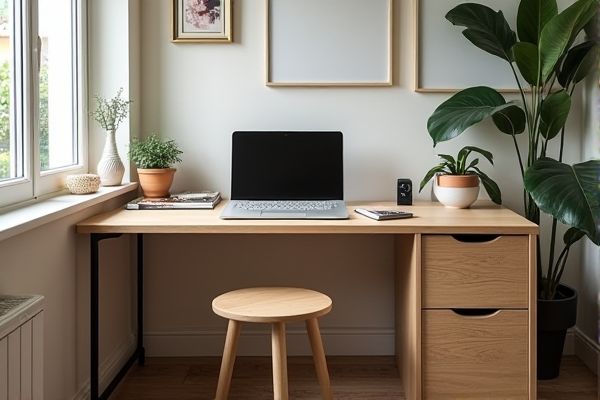
A study desk is designed for versatile use, often featuring additional storage and a larger surface area to accommodate various tasks, while a writing desk is typically smaller and more minimalist, focusing on providing a dedicated space for writing. Understanding these differences can help you choose the best desk for your needs; explore the rest of the article to find out which option suits your personal workspace.
Table of Comparison
| Feature | Study Desk | Writing Desk |
|---|---|---|
| Primary Use | Designed for studying, reading, and computer work | Optimized for writing and paperwork tasks |
| Design | Often larger with multiple compartments and shelves | Simpler, minimalist design with a flat surface |
| Storage | Includes drawers, shelves, and organizers | Limited or no storage features |
| Ergonomics | Ergonomically designed for extended use | Basic ergonomics, suited for short writing sessions |
| Materials | Wood, metal, or composite materials | Primarily wood or wood veneer |
| Typical Size | Medium to large size | Small to medium size |
| Common Users | Students, professionals needing workspace | Writers, calligraphers, and casual users |
Understanding Study Desks vs Writing Desks
Study desks are designed with multifunctional features such as storage compartments, adjustable heights, and ergonomic designs to support prolonged use in educational or professional settings. Writing desks typically emphasize simplicity and a flat, spacious surface optimized for focused handwriting and minimal distractions. Choosing between a study desk and a writing desk depends on the need for additional functionality versus a streamlined workspace dedicated solely to writing tasks.
Key Differences Between Study and Writing Desks
Study desks typically feature ample storage like shelves and drawers designed for organizing books, stationery, and study materials, whereas writing desks emphasize a minimalist design with a flat surface ideal for writing or using a laptop. Study desks are often larger, catering to extended use with space for multiple tools, while writing desks prioritize simplicity, supporting focused writing tasks. Choosing the right desk impacts Your productivity by aligning workspace features with Your primary activities.
Design Features of Study Desks
Study desks feature ergonomic designs with adjustable height and ample surface space to accommodate books, laptops, and study materials, promoting comfort during extended use. They often include built-in storage solutions such as drawers, shelves, or compartments to organize stationery and documents efficiently. In contrast to writing desks, study desks emphasize functionality and versatility, incorporating cable management systems and integrated lighting to enhance productivity.
Design Features of Writing Desks
Writing desks typically feature a compact, minimalist design tailored for focused tasks, including a flat surface with integrated compartments or drawers for storing stationery and documents. Unlike study desks, they often emphasize aesthetics with ornate details, high-quality wood finishes, and antique-inspired elements that elevate your workspace's style. Their structured layout promotes organization and creativity, making them ideal for brief writing sessions or artistic endeavors.
Purpose and Functionality Comparison
A study desk is designed to support a broad range of academic and work activities, featuring ample surface area and storage options for books, laptops, and stationery, enhancing productivity and organization. Writing desks are typically more compact and focused on providing a dedicated space for handwriting tasks, often without extensive storage, emphasizing simplicity and ergonomics. Prioritizing the intended use, study desks accommodate multitasking and digital work, whereas writing desks cater to traditional pen-and-paper writing needs.
Storage Options: Study Desk vs Writing Desk
Study desks typically offer extensive storage options, including multiple drawers, shelves, and compartments designed to organize books, stationery, and electronic devices efficiently. Writing desks, in contrast, often feature minimal storage, usually limited to a single drawer or none at all, prioritizing a clean, uncluttered workspace for focused writing tasks. The choice depends on needs: study desks support multitasking and storage demands, while writing desks cater to simplicity and limited storage requirements.
Material and Style Considerations
Study desks typically feature durable materials like hardwood or metal to withstand daily use and offer ergonomic designs focused on functionality, while writing desks often showcase elegant wood finishes such as mahogany or oak that emphasize classic style and aesthetics. Your choice between the two should consider both the material's durability and the desk's design to match your workspace decor and usage needs. Prioritizing style in a writing desk enhances visual appeal, whereas study desks prioritize practicality and comfort for extended work sessions.
Ergonomics and Comfort Factors
Study desks prioritize adjustable height and ample legroom to support prolonged use, reducing strain on the back and neck, while writing desks emphasize a more compact design with a slanted or flat surface tailored for comfortable handwriting posture. Ergonomic features in study desks often include built-in cable management and customizable components to accommodate various tasks, enhancing comfort during extended study sessions. Writing desks typically focus on simplicity and portability, with surfaces positioned to promote natural wrist alignment and minimize fatigue during short-term writing activities.
Ideal Users for Each Desk Type
A study desk is ideal for students and professionals who require ample space for computers, books, and multitasking activities, offering ergonomic features for prolonged use. Writing desks suit writers, artists, or minimalists who prefer a compact surface primarily for handwritten notes and creative tasks. Your choice depends on whether you prioritize expansive workspace or a streamlined area tailored for focused writing.
Choosing the Right Desk for Your Needs
Choosing the right desk depends on your primary activities: a study desk is designed for multitasking and storage, often featuring shelves and drawers to organize books, stationery, and study materials efficiently. A writing desk focuses on a clean, flat surface tailored for writing or using a laptop, offering minimal storage to reduce distractions. Consider your workflow and storage needs to select a desk that enhances your productivity and comfort.
 homyna.com
homyna.com